For about six years, until 2016, Jeff Ambrose worked at the Colorado Railroad Museum in Golden, Colorado, first as a volunteer and then as Restoration Manager responsible for the restoration and upkeep of all the museum’s rolling stock and its roundhouse. Over the years he was assisted by around 65 volunteers. They included his A-Team, the “Tuesday Group,” some 10 volunteers who came weekly to help Jeff with a variety of projects. In 2016, Jeff left the museum. For the Tuesday Group it was the end of an era, one they were all reluctant to leave behind.
 Rick DeWitt
Rick DeWittEric Robison, Jeff Ambrose, Jim Curtis, and Rick DeWitt (from left to right) glue up the second lower chine block. In the background, under a blue tarp, is a Night Heron kayak, which Jeff was also building at the time.
“We really enjoyed working together,” Jeff says, “so I suggested we continue the relationship by having them come over to my shop in Littleton once a week to build stuff. For about a year, maybe more, they’d come over and work on small projects—furniture, toys for grandchildren, that sort of thing. But then we ran out of projects, and we needed something to do. It didn’t really matter what we built. The object was to get together, develop our skills, and enjoy being around each other.”
Jeff had learned boatbuilding skills over a four-year period taking classes taught by Harry Bryan and Eric Blake at WoodenBoat School, and when he now suggested building a boat, everyone in the group was in favor. But what would they build? “I brought in plans and ideas, but nothing really lit them up. Then I remembered: a year or two earlier, Mike had shown me a boat that he thought was really cool.”
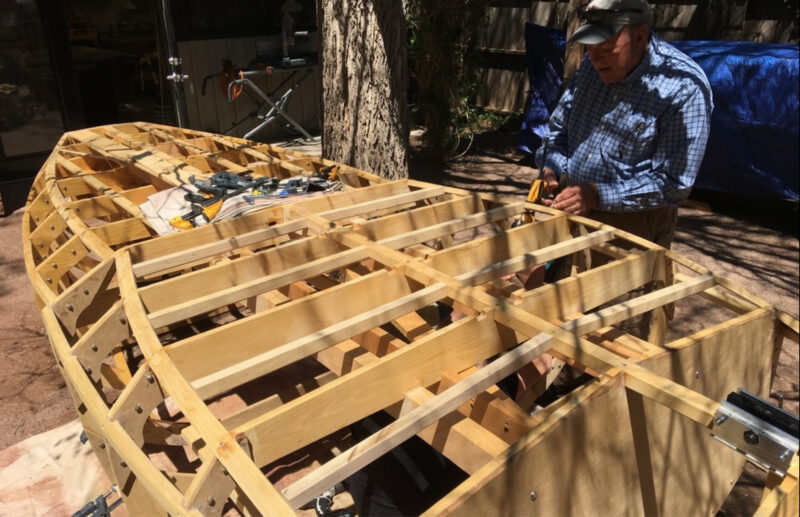 John Conover
John ConoverJim Curtis inspects the lower chine block, a three-layer piece glued-up in place. The boat’s framework was built over a jig. Frames were of solid ash with marine plywood gussets and bulkheads. The step in the lower stern portion of the hull is very evident here.
Mike is Jeff’s brother-in-law. He lives about 1,400 miles from Littleton, in Lake Havasu City, Arizona, and grew up around boats. When Mike was a kid, his father had built a couple of ski boats and finished a 30′ cabin cruiser, but Mike knew little of boatbuilding or woodworking; instead, his interests leaned to the mechanical. After his retirement, Mike had begun restoring and customizing older motorcycles, usually with his friend, Bob Fouts.
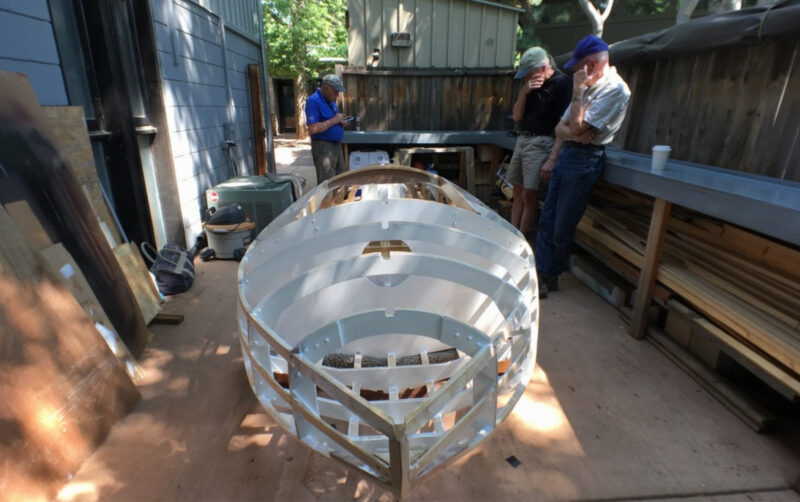 John Conover
John ConoverJim Curtis, Jeff Ambrose, and Eric Robison (from left to right) consider the next steps in construction. The boat had been moved from the back yard to the side yard where there was less space to move around but it could be easily covered by a tarp strung from the fence to the house. Parts of the boat were painted at this early stage because the builders realized they would never be so accessible again.
When Jeff called to ask about that cool boat, the conversation evolved quickly.
“I told him the guys were looking for something to do,” says Jeff, “and what would he think if we built a boat up in Littleton and then got it down to him for the mechanics?”
Mike was in.
The boat Jeff had been thinking of was the Crandall Flyer 15, designed by Bruce Crandall in 1936 to the “135 cu in” C-class rules established that same year. The article Mike had found was written by Willard, Bruce Crandall’s brother, and was published in the July 1936 issue of Motor Boating. In it, Willard described the 15′ 2″ single-step racing hydroplane as being “designed to give maximum speed, but maximum speed under normal competitive conditions. Factors of design giving straight-away speed, turning ability, and ability to ride rough water have been so proportioned that in an actual race a high peak of speed is reached…” The Flyer 15 was, Willard Crandall continued, “designed on the principle of carrying most of the weight on the foreplane, so that a wide afterplane is not necessary.” The resulting hull is narrow, without flare, and streamlined with a torpedo stern.
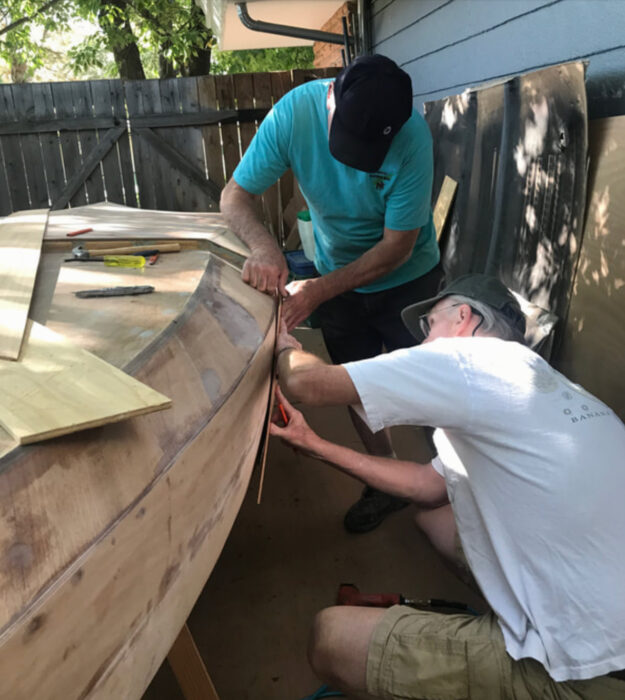 Eric Robison
Eric RobisonRick DeWitt (above) and John Conover (below), measuring up for the first diagonal layer of mahogany veneer on the port side.
Jeff took the article in to show the guys. “They were excited from the start. It really is a cool-looking thing. So off we went.”
The boatbuilders were a group of seven, including Jeff. Six had met through the railroad museum and the seventh was Rick DeWitt, a neighbor who “mistakenly stopped by one day to see what we were up to,” remembers Jeff.
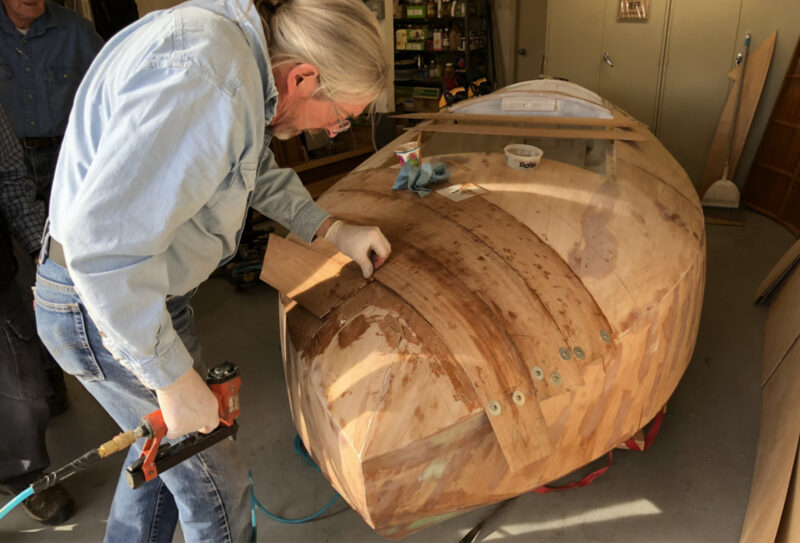 John Conover
John ConoverThe boat was moved into Jeff’s garage for the winter. Here, Jeff applies the first diagonal layer of mahogany veneer to the foredeck.
Deciding to build the Crandall Flyer 15 was the easy part; more challenging was finding lines drawings. The Motor Boating article included some drawings and a table of offsets, and Jeff was considering lofting the Flyer when, in one of his many forays through the internet, he found Classic Wooden Boat Plans, an online business that has, within its catalog of plans, a set for the Crandall Flyer 15 that includes full-sized plans and a digital 3D model, “which allowed us to spin the boat around and see it from all angles.” Jeff bought the set and recalls, “we did run across some issues in the plans but that’s all part of boatbuilding. On the whole, they were good.”
The Willard Crandall article described the construction of the Flyer 15 and while Jeff adhered to the original dimensions and scantlings, he veered away from some of the proposed building materials. “The article said that the boat’s frame should be in spruce,” says Jeff, “but that’s not the easiest wood to work with or to source, so we switched to ash. There was also talk of lapping the joints on the frames, but we opted for glued and stainless-steel-screwed butt joints with plywood gussets. The hull was originally batten-seam planked, but with today’s materials we decided to cold-mold it instead: three layers of 1⁄8″ mahogany—the inner layer laid fore and aft, the next two on opposing diagonals. The bottom of the boat, aft of the step, where there’s almost no curve at all, we fashioned from 3⁄8″ marine plywood, and for the deck we used 1⁄8″ plywood topped by 1⁄8″ mahogany. In all it’s probably heavier than the original, but we were going for durability rather than a true lightweight racer.”
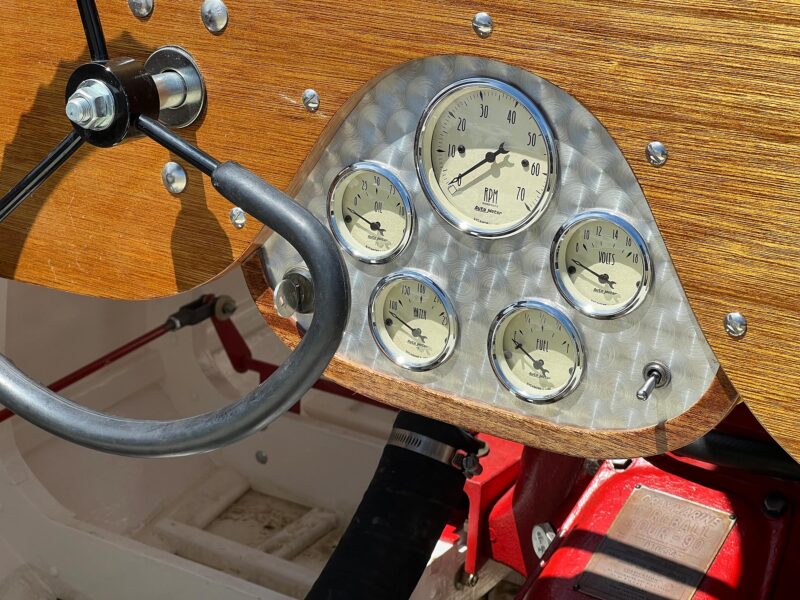 John Conover
John ConoverCurtis Cain, one of the original members of the Tuesday Group, fabricated the turned metal for the vintage-look instrument panel.
In recent years there have been discussions on classic-boat and yacht-design forums as to the safety of the Flyer 15’s design and its apparent instability if taking tight turns at high speed. But the building team in Colorado was in it for the look of the boat. “We didn’t put a lot of thought into what we’d do with it when it was finished,” says Jeff. “It really was just a matter of ‘what a neat project this would be.’ I don’t know that it does perform that well as a [practical] boat, but as a woodworking project, an art object, it’s perfect.”
The Colorado building team began work in 2017. By early 2019 the boat was finished. All it needed now was the engine to be installed. Around the time the project was winding up, Jeff was busy relocating to North Carolina and, he says, “in a spirit of generosity one doesn’t expect from a brother-in-law,” Mike drove up to Denver and trailered the boat back to Lake Havasu City. It was time for the mechanical phase of the project to begin.
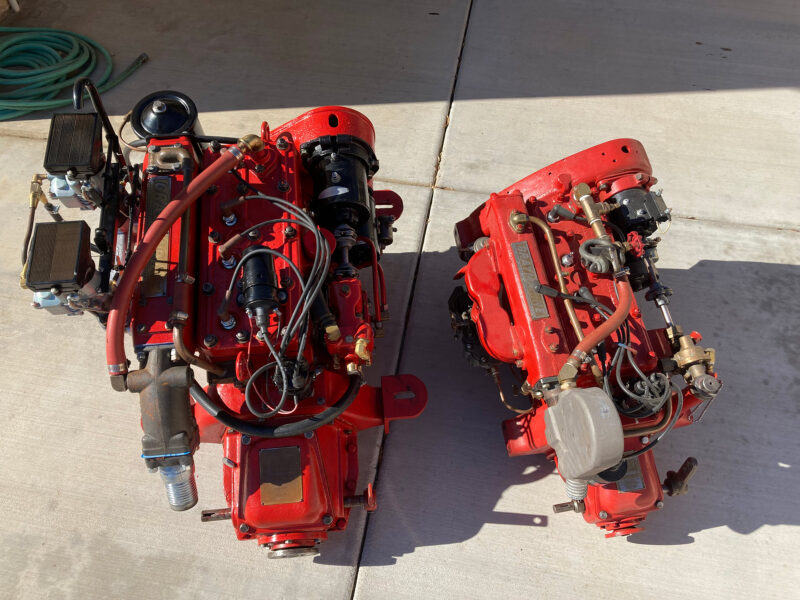 MIke Slattery
MIke SlatteryThe difference in the size of the two restored vintage engines is obvious when seen side by side. On the right is the Gray Marine Phantom 45, which was physically the perfect size but underpowered for the boat. On the left is the Gray Marine Fireball 90, which delivered sufficient power but required some structural adjustments.
Finding an engine had been a challenge. “It’s a small boat,” says Mike, “and the engine compartment is very confined, so the power options weren’t limitless. We needed a vintage flat-head marine engine with an integral transmission. Anything else wouldn’t fit.” While the boat was still in build, one of the building crew located a period-correct 45-hp Gray Marine Phantom 445 engine. It was in Michigan, sitting on a rack where it had been for the past 30 years. Thinking it would be perfect Jeff, Mike, and Jim Curtis, one of the boatbuilders, drove east to get it.
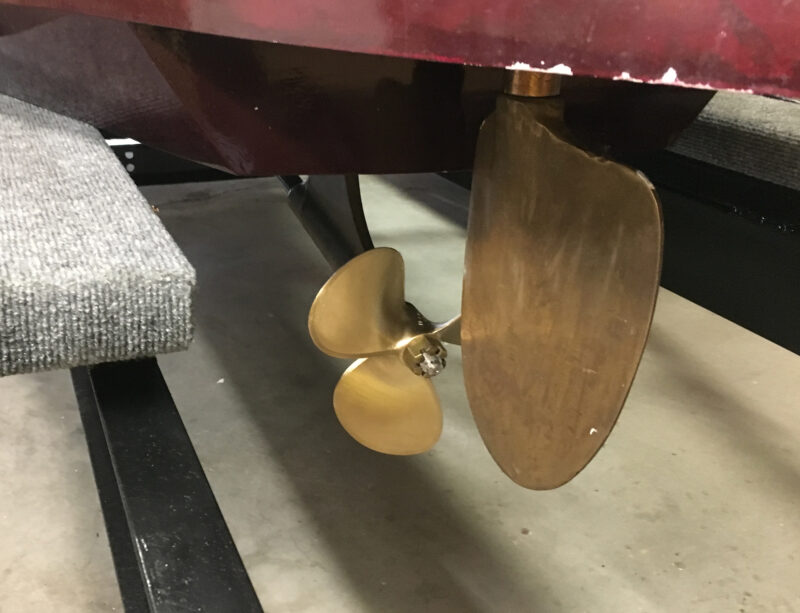 Mike Slattery
Mike SlatteryA vintage rudder was located at a shop on Lake St. Claire, Michigan. Mike is considering extending the rudder shaft to better position it in the water flow beneath the hull; it is hoped that this will improve the boat’s maneuverability at speed.
Over the next few months, as the build had been drawing to a close in Colorado, Mike had taken the engine apart, rebuilt it, and got it running. When the boat at last arrived in Arizona, the engine was ready, and the boat was ready to receive it. Mike had never done a mechanical installation on a boat before, but with 10 years of working on vintage motorcycles and having done a “ton of research and talking to people,” he was confident that, with Bob’s help, he could do what was needed. “Working on engines,” Mike says, “keeps us busy and interested in waking up the next morning.”
Mike and Bob installed the engine—making their own motor mounts—and in September 2019 they took the boat for a speed trial on Lake Havasu. “We quickly found out that 45 hp wasn’t going to get the boat up onto a plane. I don’t know what speed we were getting but the engine just wouldn’t turn over more than 2,100 rpm and peak horsepower in the Phantom 445 can only be achieved at 3,000 rpm.” Searching for solutions and still hoping they could get the engine to work, Mike installed a smaller propeller with less pitch to see if that would help. It didn’t, he says, “and at $480 a pop I wasn’t about to start buying propellers on spec.”
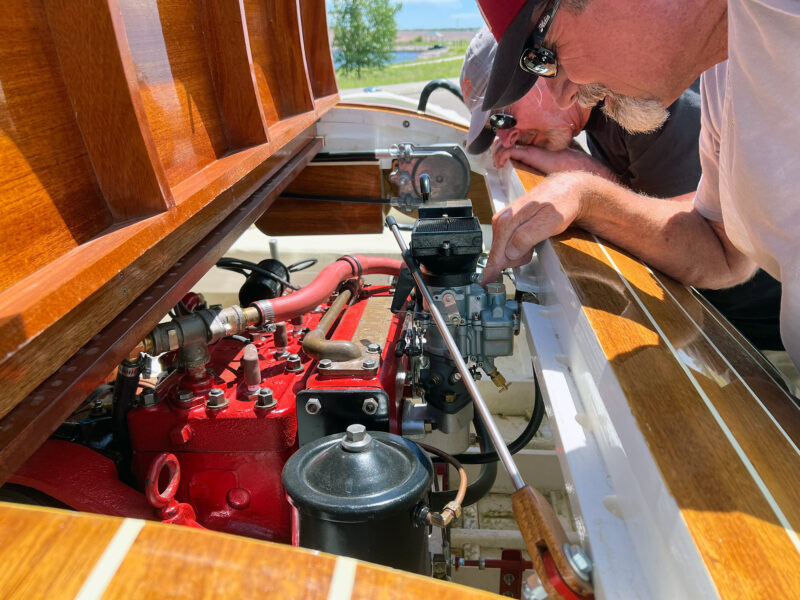 John Conover
John ConoverThe engine compartment is a very tight fit. Because the second engine was larger than the original, a vent was added to the engine cover, and a bite was taken out of the frame.
Mike considered his options. For a while he thought about getting a modern engine and shoehorning it into the Flyer. He even went as far as buying a $300 boat that had a “really nice MerCruiser 120-hp, four-cylinder engine.” He cleaned up the engine, got it running, cut up the old fiberglass boat, and took the pieces to the dump. However, once he had extracted the engine from the boat and was able to measure it properly, he realized that its weight would be too far forward and too high. He sold it and moved on. “I made a couple of bucks, so it was okay.”
The Mercruiser idea a dud, Mike was back on the hunt for a period engine. At last, on eBay, he found a Gray Marine Fireball 90, “an engine,” he says, “made for high-performance boats in the 1940s.”
 MIke Slattery
MIke SlatteryMike Slattery and Bob Fouts finished painting the hull in Mike’s shop in Arizona. The group had chosen the classic racing colors offset by the varnished deck, but it was Mike and Bob who perfected the finish.
In January 2022, the Fireball was shipped from Massachusetts to Arizona. “It had been sitting in a warehouse and was completely frozen,” Mike says, “so I had to tear it apart and do a complete rebuild. Fortunately, it didn’t seem to have too many hours on it, plus I was able to get all the parts I needed.” During his research, Mike had come across David Van Ness at Van Ness Engineering in Fairfield, New Jersey. “When Gray Marine went out of business Dave bought all their hardware, so he’s the source for all things vintage Gray,” Mike says. “He’s not the easiest to get in touch with but he’s very generous with advice and information, and through long-distance phone calls he led me through the rebuild. Thanks to him I got it back up and running.”
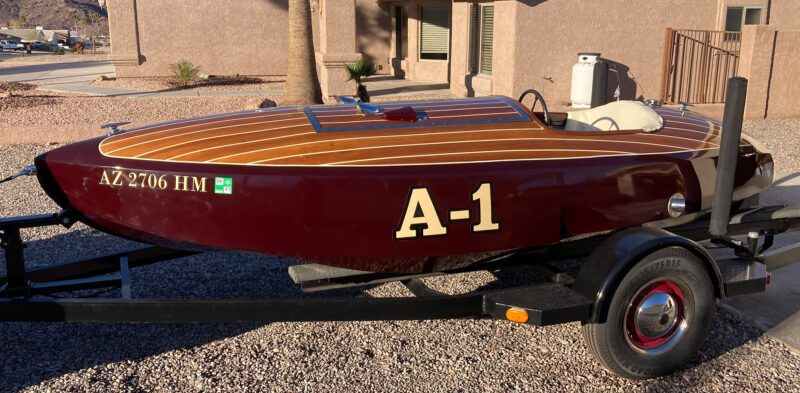 Mike Slattery
Mike SlatteryThe completed boat ready to be towed back to Colorado on a used trailer that Mike and Bob customized. Mike chose the boat’s name because the paint color reminded him of the well-known steak sauce.
When Mike and Bob relaunched the Flyer in September 2023 it “jumped right up on plane.” But, Mike says, there’s still room for improvement. “It still doesn’t go very fast because the prop is now too small and doesn’t have enough pitch to get the most out of the new engine. I’m sure if I spent another $500, I could get a more appropriate propeller and then we could start pushing the boat into the zone for which it was designed.” Which, adds Jeff, “scares the hell out of both of us.”
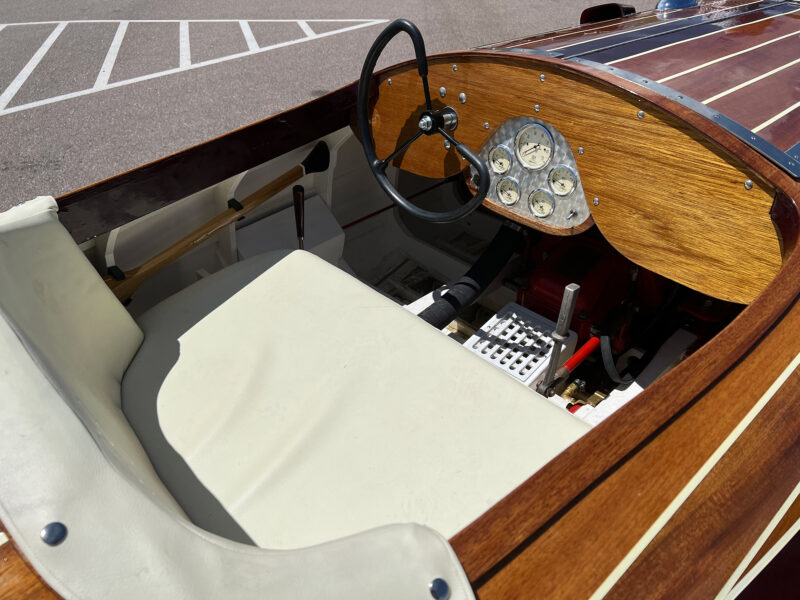 John Conover
John ConoverAlthough the cockpit layout is true to the original, the seat back—which is removable to allow access to the fuel tank—was designed by the Tuesday group and laminated over a mold in Jeff’s shop. The cushions were upholstered by Diane Slattery.
For now, the Flyer, with its undersized propeller and under-performance stats, remains in Arizona. Mike and Bob did trailer it up to Colorado in the fall so that everyone who had helped in the build could drive it around on a local reservoir. “It wasn’t the best outing,” says Mike. “Because of the higher elevation in Colorado the engine ran very rich, but it was still a lot of fun.” There are still one or two small mechanical issues to be fixed, which Mike was planning to do as soon as the daytime temperatures in Arizona eased up, but after that no one is quite sure. Lake Havasu, which straddles the border between Arizona and California, has no speed limit and, says Jeff, “is the hydroplane capital of California.” It might be an appropriate place to put the Crandall Flyer 15 through its paces.
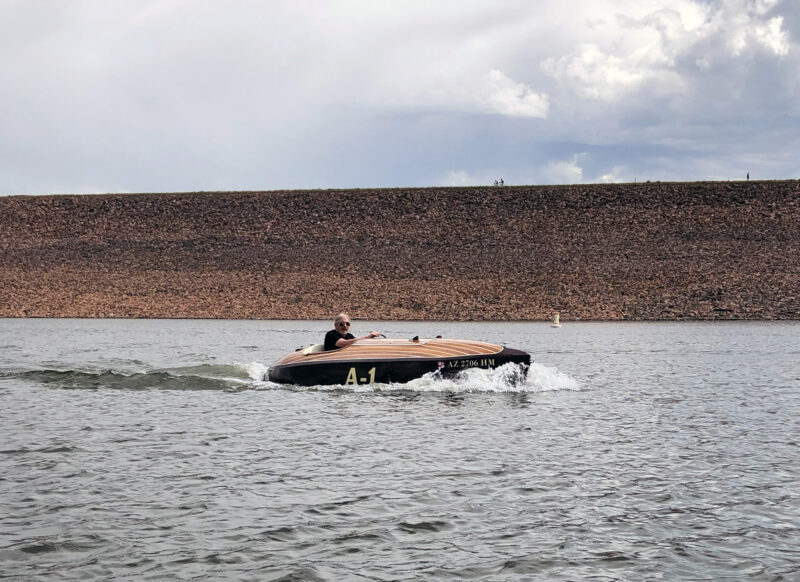 Kathy Ambrose
Kathy AmbroseWith Jeff at the helm, the A-1 was finally underway at Chatfield Reservoir, Colorado. This was the first opportunity for the Colorado building team to see the boat finished and to try it out on the water.
“Without question the project has been a success,” Jeff says. Its creators were separated by almost 1,500 miles, and “start to finish, it’s taken nearly seven years—not many projects can be sustained so long.” What happens next may be undecided but, Mike says, “I think I’d like to drive it around at least once when it’s actually performing properly. Then I guess we’ll sell it and maybe we’ll all go out to dinner some time. It really was the challenge of doing the thing.”![]()
The Crandall Flyer 15 building crew in Colorado were: Eric Robison, Jim Curtis, Rick DeWitt, Curtis Cane, John Conover, Bob Wilson, and Jeff Ambrose; and in Arizona: Mike Slattery, Bob Fouts, and Diane Slattery—who upholstered the seat and its custom-designed curved back.
Jenny Bennett is managing editor of Small Boats.
Do you have a boat with an interesting story? Please email us. We’d like to hear about it and share it with other Small Boats readers
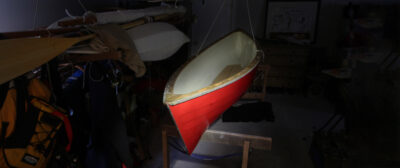
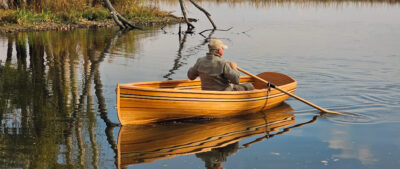
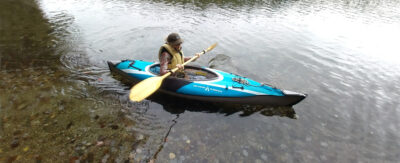
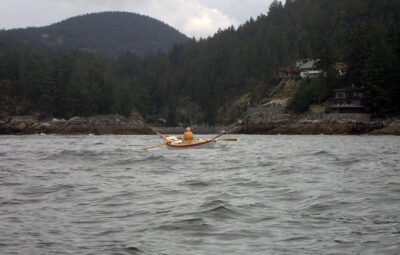
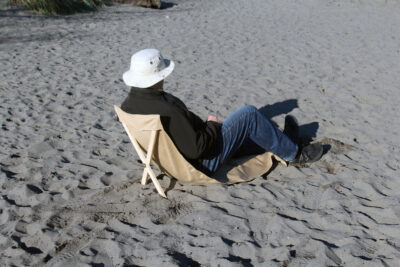
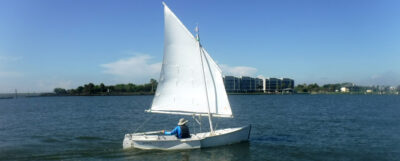
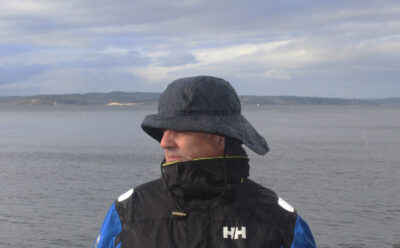
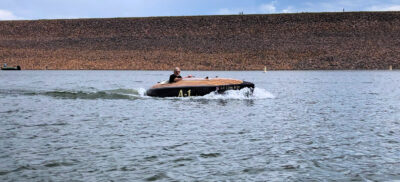
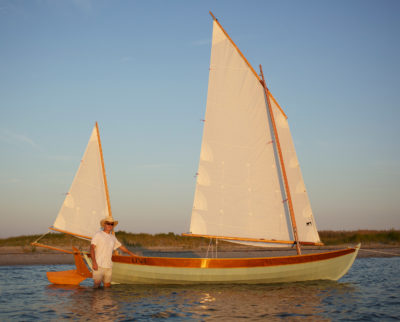
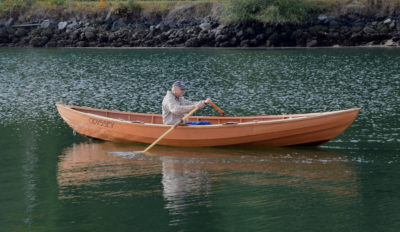

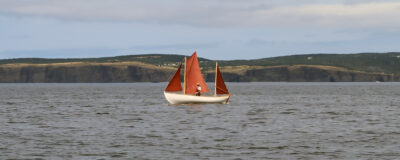
So glad to see something that beautiful out on Chatfield! Well done. That was the first place I set foot on a boat and now I’ve had a career in the maritime industry for almost a decade. I recognized the dam(n) wall at the header immediately!
Well done on a beautiful craft.
I’m a month late reading this great article. A great project!
With so many lookalike boats around, it is a nice change to see something less usual and I’m sure you get lots of looks and compliments.
Wunderbar!!